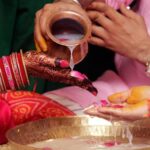Are you interested in learning how to become a wedding dress designer? The allure of helping brides bring their dream dresses to life and exploring the creativity and artistry in the fashion industry makes this career path an exciting and rewarding choice. In this article, we will explore the necessary steps and skills required to pursue a career as a wedding dress designer.
To start a successful career as a wedding dress designer, formal education in fashion design is essential. Whether through traditional education or specialized training in bridal and wedding dress design, acquiring the necessary skills and knowledge is crucial. Additionally, gaining experience through internships and apprenticeships can provide valuable hands-on experience in the field.
Cultivating design skills, staying updated with current fashion trends, and learning to sketch and create patterns for wedding dresses are important aspects of becoming a successful wedding dress designer. Understanding the bridal market, researching preferences of brides, recognizing different styles of wedding dresses, and identifying your target audience also play a pivotal role in standing out in this competitive industry.
Education and Training
When it comes to pursuing a career as a wedding dress designer, having the right education and training is essential. Here are some key steps on how to become a wedding dress designer through education and training:
- Formal Education: Pursuing a degree in fashion design or a related field from a reputable institution can provide you with the foundational knowledge and skills needed for a career in wedding dress design. Courses in pattern making, draping, and textile design are particularly valuable for aspiring designers.
- Specialized Training: Consider enrolling in specialized programs or workshops that focus specifically on bridal and wedding dress design. These programs often offer hands-on experience and mentorship from industry professionals, allowing you to learn the intricacies of creating beautiful and functional wedding dresses.
- Internships and Apprenticeships: Gaining practical experience through internships at bridal fashion houses or apprenticeships with established wedding dress designers can be invaluable. These opportunities allow you to apply your skills in a real-world setting, build connections within the industry, and gain insights into the business side of wedding dress design.
By investing in your education and training, you can develop the technical expertise and creative vision necessary to succeed as a wedding dress designer.
Remember that becoming an expert in this field requires continuous learning and dedication throughout your career. Stay updated with the latest techniques, technologies, and trends in bridal fashion to refine your skills and stay ahead in the competitive market. With the right education and training, combined with passion and perseverance, you can turn your dream of becoming a wedding dress designer into a reality.
Developing Your Design Skills
Becoming a successful wedding dress designer requires a strong foundation in design skills. To start your journey on how to become a wedding dress designer, it is essential to cultivate a keen eye for details, fabric, and textures.
Paying attention to the intricacies of different fabrics and understanding how they drape and move is crucial in creating beautiful wedding dresses that brides will love. Additionally, staying updated with current fashion trends is important to ensure that your designs are relevant and appealing to your target audience.
Learning to sketch and create patterns for wedding dresses is another vital aspect of developing your design skills. The ability to bring your creative vision to life through sketches and patterns is essential in the wedding dress design process. By mastering this skill, you can effectively communicate and translate your ideas into stunning bridal gowns.
In addition to these aspects, it’s also important to develop a strong sense of style and aesthetics. Understanding color theory, silhouette, and proportion will contribute greatly to your success as a wedding dress designer. Embracing creativity and taking risks with your designs will set you apart in the competitive bridal market. As you focus on developing these design skills, remember that practice makes perfect, so don’t be afraid to experiment and push the boundaries of traditional bridal fashion.
| Aspect | Importance |
|---|---|
| Fabric knowledge | Understanding fabric composition helps in creating beautiful designs |
| Fashion trend awareness | Staying updated ensures that your designs remain relevant |
| Drawing and pattern-making ability | Essential for effectively communicating and translating design ideas |
Understanding the Bridal Market
When it comes to becoming a wedding dress designer, understanding the bridal market is crucial for success. This involves researching the preferences of brides and staying updated on current wedding trends. Here are some essential steps to help you understand the bridal market:
- Researching the preferences of brides: To become a successful wedding dress designer, it’s important to conduct thorough research on what brides are looking for in their dream dresses. This may include factors such as preferred fabrics, popular styles, and desired embellishments.
- Recognizing different styles and silhouettes of wedding dresses: As a designer, being able to identify and understand various styles and silhouettes of wedding dresses is key. Whether it’s ballgown, mermaid, A-line, or sheath, having a strong knowledge of these designs will allow you to cater to a wide range of bridal preferences.
- Identifying the target audience and market for your designs: Understanding your target audience is vital in creating designs that resonate with potential clients. Whether you’re catering to traditional brides, modern brides, or destination wedding brides, knowing your market will help guide your design process.
By mastering these aspects of the bridal market, you’ll be better equipped to create designs that appeal to brides and set yourself apart as a sought-after wedding dress designer.
Building a Portfolio
Creating a strong portfolio is essential for aspiring wedding dress designers. This comprehensive collection of your best work will serve as a visual resume, showcasing your design aesthetic, style, and skills. A well-curated portfolio can help you stand out in a competitive industry and attract potential clients or employers. Here are some key steps to building an impressive portfolio:
Curating a Diverse Collection
Include a variety of designs that demonstrate your versatility and range as a wedding dress designer. Showcasing different styles, silhouettes, and fabric choices will highlight your ability to cater to diverse bridal preferences.
High-Quality Imagery
Invest in professional photography to capture the essence of your designs. High-quality images will elevate the overall presentation of your portfolio and provide potential clients with a clear view of your craftsmanship.
Consistency in Style
Ensure that your portfolio reflects a cohesive design aesthetic that sets you apart from other designers. Whether it’s vintage-inspired lace gowns or modern minimalist dresses, maintaining consistency in style will help define your brand identity.
Projects and Collaborations
Include any relevant projects or collaborations related to wedding dress design. Whether it’s participating in bridal fashion shows, working with brides on custom designs, or assisting established designers, these experiences will add value to your portfolio.
By following these strategies, you can effectively showcase your talent and expertise as a wedding dress designer through a compelling portfolio that leaves a lasting impression on potential clients or employers.
Establishing a Professional Network
Becoming a successful wedding dress designer not only involves honing your design skills but also establishing a strong professional network within the bridal and fashion industry. Connecting with bridal shops, fashion boutiques, and wedding planners is crucial in getting your designs noticed and securing potential clients. Building relationships with fabric suppliers, dressmakers, and seamstresses is also essential as they play a vital role in bringing your designs to life.
One way to start building your professional network is by attending industry events such as bridal shows, fashion weeks, and networking mixers. These events provide an opportunity to meet potential collaborators and showcase your work to a wider audience. Additionally, reaching out to established wedding dress designers for mentorship or guidance can provide invaluable insight into the industry and open doors for collaboration or apprenticeship opportunities.
In addition to attending events and seeking mentorship, utilizing social media platforms can also help expand your professional network. Creating an online presence through platforms like Instagram or Pinterest allows you to connect with other industry professionals, engage with potential clients, and showcase your portfolio to a global audience. Remember that establishing a professional network is an ongoing process that requires proactive engagement with others in the industry.
Launching Your Career
Setting Up a Business or Working for a Bridal Fashion House
After completing your education, gaining experience, and building a portfolio, it’s time to launch your career as a wedding dress designer. One option is to establish your own business, where you can create custom wedding dresses for individual clients or even develop a ready-to-wear line for bridal boutiques. Alternatively, you may choose to work for an established bridal fashion house, where you can learn from experienced designers and contribute to the creation of their collections.
Promoting and Marketing Your Designs
In order to succeed as a wedding dress designer, it’s essential to effectively promote and market your designs. Utilize social media platforms like Instagram and Pinterest to showcase your work and connect with potential clients. Additionally, consider participating in bridal events such as wedding fairs or trunk shows to present your designs to a larger audience. Collaborating with photographers and wedding planners for styled photoshoots can also help in promoting your work.
Establishing a Brand and Identity
As you embark on your career as a wedding dress designer, focus on establishing a strong brand identity that reflects your design aesthetic and style. This could include creating a distinctive logo, developing a cohesive visual presence online and offline, and defining the unique aspects of your designs that set them apart in the market. Consistency in branding will help build recognition of your work within the bridal industry.
By following these steps in launching your career as a wedding dress designer, you can begin establishing yourself within the industry and creating beautiful gowns that fulfill the dreams of brides-to-be.
Overcoming Challenges and Staying Inspired
In the competitive and ever-evolving world of fashion design, becoming a successful wedding dress designer comes with its own set of challenges. However, by staying inspired and resilient, you can overcome these obstacles and thrive in the industry. One of the most important aspects is to continuously seek inspiration and find creative ways to stay motivated.
As a wedding dress designer, it is crucial to constantly stay updated with the latest trends in bridal fashion. By attending fashion shows, keeping an eye on influential designers, and immersing yourself in the world of weddings, you can gain valuable insights that will keep your designs fresh and desirable. Additionally, networking with other professionals in the industry can provide you with new perspectives and ideas that fuel your creativity.
Furthermore, continuing education plays a vital role in staying inspired as a wedding dress designer. By learning new techniques, exploring different fabrics, and experimenting with various styles, you can push the boundaries of your creativity. Whether it’s through workshops, courses, or self-study, investing in your skills will ensure that you remain at the forefront of bridal fashion.
In conclusion, navigating the path to becoming a successful wedding dress designer may be challenging but staying inspired through continuous education and seeking inspiration from various sources are essential steps in overcoming these challenges. By remaining dedicated to your craft and pursuing opportunities for growth within the industry, you can establish yourself as a reputable and sought-after designer in the world of bridal fashion.
Frequently Asked Questions
What Do You Need to Be a Wedding Dress Designer?
To become a wedding dress designer, you need to have a strong sense of creativity, fashion design skills, and knowledge of textiles and sewing techniques. It’s also important to have strong communication skills to understand the bride’s vision and bring it to life.
How Do You Become a Wedding Dress Maker?
Becoming a wedding dress maker typically involves pursuing formal education in fashion design or a related field. This could include obtaining a degree from a fashion design school or completing an apprenticeship with an experienced wedding dress maker. Attention to detail, patience, and the ability to work well under pressure are essential qualities for this career.
How Long Does It Take a Designer to Make a Wedding Dress?
The time it takes for a designer to make a wedding dress can vary depending on factors such as complexity of the design, availability of materials, and the designer’s schedule. On average, it can take anywhere from 4 to 9 months from initial consultation to final fitting for the bride.
This timeframe allows for multiple fittings, meticulous construction, and any necessary alterations to ensure the perfect fit for the big day.

I have been involved in marriages for over 20 years helping couples and singles understand more about them.





